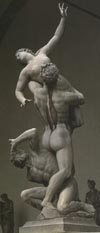
=================

by Guy Shaked
Keywords: Giambologna, Galleria dell'Accademia, Rape of the Sabines, Romulus, Shaked
Bernini’s idea of complex relations in the vertical axis of statues finds its source in the statue of the Rape of the Sabines by Giambologna [figura serpentina]. In his statues Bernini developed the idea into a full system that underlines many of his creations.
The statue depicts Romulus, the mythological founder of Rome while he carries off a Sabine woman [1]. She of course objects and tries to release herself from his hold. It is possible that in memory of this mythological event formed the custom of carrying the bride over the threshold of the door when just married [2].
The identity of the woman Romulus carries is uncertain. It is possible that she is Hersilia, as Plutarch mentions some say that Romulus himself raped this woman. She was not a virgin, but rather a married woman, unlike the other Sabines the Roman carried to rape. This cruelty is thus less horrible in the eyes of Plutarch, as he states that all the Sabines but her were virgins and not married women and therefor the crime was lessened and meant actually to form alliance with the Sabines, by creating blood ties with them [3].
Of course the rape will not bring Romulus glory to his name, however the scene depicted in the lower part of the statue will. It is the commander of the Sabines – Acron, king of the Ceninenses, holding his hand in fear as he succumbs to the might of Romulus. It is Acron’s figure that identifies the statue as the rape of the Sabines and not that of Helen of Troy or Proserpina [4]. The scene depicted in the lower part of the statue is occuring after the rape of the Sabines women, For then, the Sabines pledged war on the Romans, and when the two forces met, it was suggested that the battle would be fought between the two camps’ generals, Romulus and Acron. In the battle, Romulus prevailed and won also glory as leader-warrior that killed by his own hands an enemy commander. Only two other heroes that won such an honor are mentioned by Plutarch (1st Century AD). These are Cornelius Cossus and Claudius Marcellus [5].
It appears, therefor, that the statue does not depict a moment in the life of Romulus, but rather the two most important and famous points in his life. While giving the appearance that the occurrence above, the rape of the Sabine woman is the more important for the statue main axis of movement is upward. The more important event that was a battle to life and death, is bellow. Therefore, this statue can be seen as a precedent of Bernini’s handeling of the vertical axis in his statues.
=================================================================
[1] It is possible, if one accepts the story on the naming of the statue in the “Riposo” of Borghini (1584) (see. Pope- Hennessy, Pope-Hennessy, J., Italian High Renaissance and Baroque Sculpture, Cit., p. 384), that Giambologna depicted in this statue a proud young man that is carrying off a beautiful young girl from an old man. Therefor the name and subject of the statute was only later given to it by Raffaello Borghini. Thus, the complex interplay in the vertical axis that is in this statue, and that probably also influenced Bernini was born by coincidence (like some great scientific inventions in history) and not by pre-planing.
[2] Plutarch, Romulus, “Plutarch’s Lives”, (Perrin, B., tr.), Cambridge, Harvard University Press, 1959, Chapter 15:4-6, pp.133-135
[3] Plutarch, Cit., Chapter 14:5-7, pp.129-131
[4] For when Giambologna made before a small Bronze statuette resembling this statue (Museo e Gallerie Nazionali di Capodimonte, Naples), without the figure of Acron, he noted in a letter to Ottavio Farnese, Duke of Parma that the subject of the statuette (without the figure of Acron) could be any on of these three scenes. See Avery, C., Redcliffe, (eds), Giambologna: Sculpture to the Medici, London, Arts Council of Great Britain, 1978, p. 105-106.
[5] Plutarch, Cit., Chapter 15:3-16:8, pp. 135-139
© 2006
Dear visitor, please take a short moment to sign my guest book!
----------------------------------------------------------------

Emails are
gladly received : shakedtg@hotmail.com
Donatello's Bronze David
A synagogue painting from Dura Europos
Hidden symbolism in Bernini's 'David'
The Nudity of Michelangelo's David
The rays of Michelangelo's Moses as the sign of the betrayed
The Trevi Fountain as the soul in love and the flood that would not drown the church
The Tritone (Triton) fountain as the Glaucus fountain
The
painting "Libreria Musicale" (Musical Library) by Giuseppe Maria Crespi,
as a source of information on the "Storia della Musica" (History of Music)
by Father Martini
Other articles by G. Shaked:
ART -
BIBLICAL
STUDIES -
BIOLOGY
-
CINEMA
-
LITERATURE
-
MUSIC
-
PHILOSOPHY
-
PHYSICS
(ACOUSTICS)